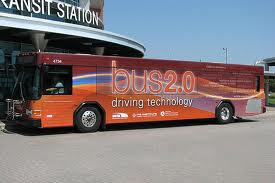AGRICULTURE
The ITS Institute’s Intelligent Vehicles (IV) Lab directed by Craig Shankwitz is working on improving transit schedule reliability. Helping bus drivers feel confident when using bus-only shoulders on suburban highways are two of the goals of the Bus 2.0 driver-assistive system currently being implemented by the Minnesota Public Transit Association.
The Intelligent Vehicles Lab MVTA and Schmitty and Sons Transportation deployed (in summer 2010) 10 DAS-equipped buses into revenue service to support narrow-bus only shoulder service between downtown Minneapolis and Apple Valley MN. Although the IV Lab has deployed a number of DAS-equipped vehicles this UPA deployment represents the first time that the system has been used to transport passengers. This deployment should prove that although DGPS systems are susceptible to periodic outages a properly designed and executed augmentation system will provide a sufficiently robust system which will be accepted by both drivers and passengers. A successful deployment will demonstrate to other transit agencies that even narrow rights of way offer significant transit advantages at low cost and that potential operational difficulties can be overcome through the use of DAS technologies.
Technology
Deployment
Driver Assist Function